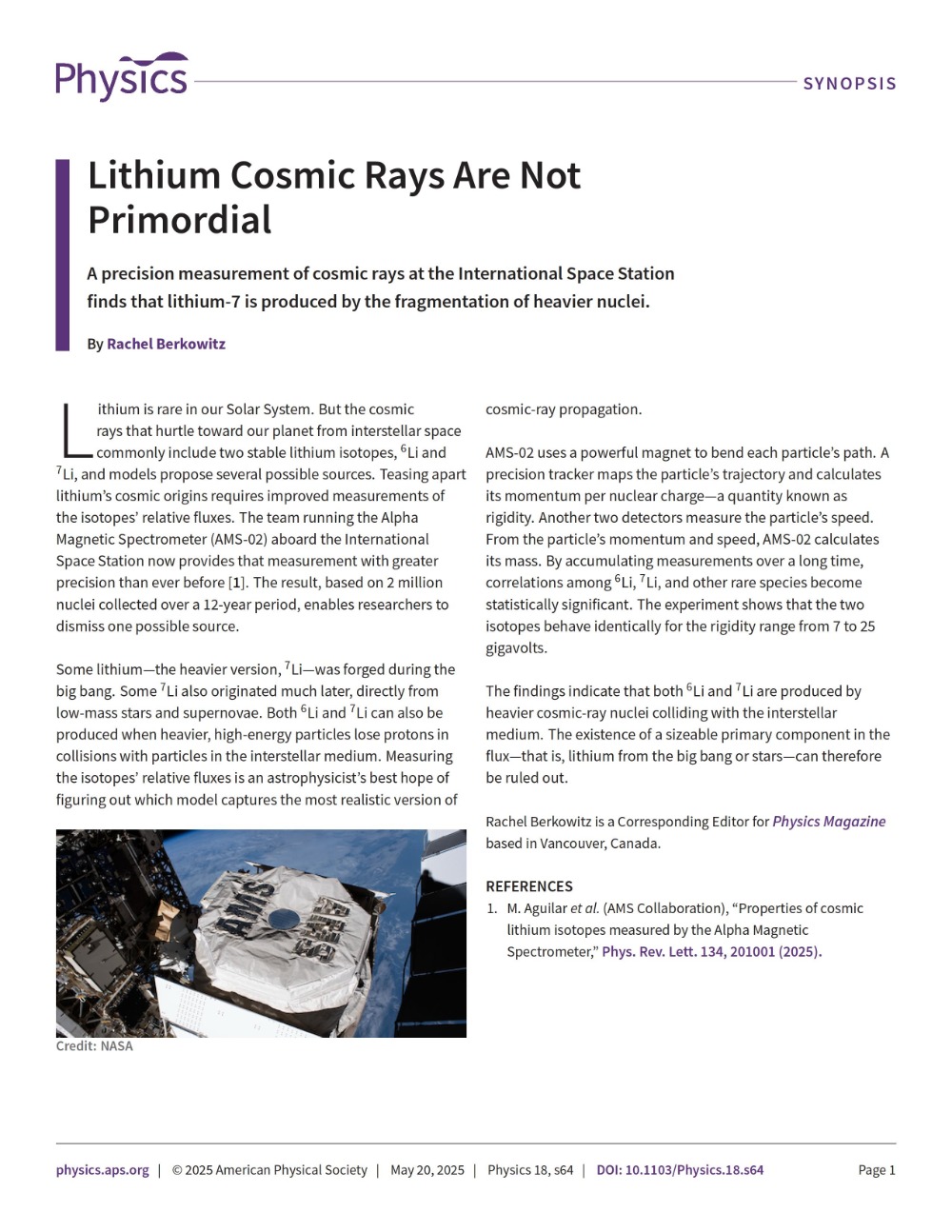著名科普杂志《Physics》报道山东高等技术研究院宇宙线研究成果
山东高等技术研究院宇宙线研究再获突破性进展,发现宇宙线中的锂-7元素主要由重原子核碎裂产生,著名科普杂志《Physics》对该成果进行了报道,原文如下:

在国际空间站上完成的一项精确测量结果发现,宇宙线中的锂-7元素主要由重原子核碎裂产生。
A precision measurement of cosmic rays at the International Space Station finds that lithium-7 is produced by the fragmentation of heavier nuclei.
太阳系中的锂元素含量非常稀少,即丰度很低。宇宙线以极高的速度从银河系深处向太阳系传播,其中蕴藏着比太阳系更加丰富的锂元素。它们主要由锂-6(6Li)与锂-7(7Li)这两种稳定的同位素构成。(译注:6Li带有3个质子和3个中子,7Li带有3个质子和4个中子,因此6Li和7Li原子核的电荷相同、质量相差一个原子质量。)理论模型指出,宇宙线中的锂元素可能具有多种不同的来源。为了完全解开锂元素起源之谜,锂同位素能谱的精确测量至关重要。在国际空间站上的阿尔法磁谱仪(AMS)实验以前所未有的精度测量了宇宙线锂同位素能谱。在超过12年的运行时间内,AMS采集了超过两百万个宇宙线锂元素事例,测量结果排除了宇宙线锂同位素一种可能的起源。
Lithium is rare in our Solar System. But the cosmic rays that hurtle toward our planet from interstellar space commonly include two stable lithium isotopes, 6Li and 7Li, and models propose several possible sources. Teasing apart lithium’s cosmic origins requires improved measurements of the isotopes’ relative fluxes. The team running the Alpha Magnetic Spectrometer (AMS-02) aboard the International Space Station now provides that measurement with greater precision than ever before [1]. The result, based on 2 million nuclei collected over a 12-year period, enables researchers to dismiss one possible source.
对于较重的锂同位素7Li,一部分是在宇宙大爆炸过程中产生的,一部分是在宇宙演化的晚一些时间,由低质量恒星和超新星爆炸直接产生的。此外,当比锂更重的原子核(译注:比如碳、氮、氧等原子核)穿行在银河系内的过程中,会与银河系空间的星际物质碰撞,产生次级的6Li和7Li。粒子天体物理学家期待测量同位素的相对流强,从而推演出能够最真实描述宇宙线传播的理论模型。
Some lithium—the heavier version, 7Li—was forged during the big bang. Some 7Li also originated much later, directly from low-mass stars and supernovae. Both 6Li and 7Li can also be produced when heavier, high-energy particles lose protons in collisions with particles in the interstellar medium. Measuring the isotopes’ relative fluxes is an astrophysicist’s best hope of figuring out which model captures the most realistic version of cosmic-ray propagation.
AMS-02通过强大的磁铁偏转带电粒子,再使用高精度的径迹探测器刻画出粒子的偏转轨迹,从而计算出粒子的刚度(即动量/电荷)。另外两种探测器测量粒子的速度。通过同时测量刚度和速度,计算得出粒子的质量(即可区分同位素)。随着宇宙线数据的累积,6Li和7Li及其他稀有成分越来越清晰的展现出来。AMS-02实验结果表明,两种同位素在刚度7 GV(GV = 109 V)至25 GV的范围内具有相同的刚度依赖性。
AMS-02 uses a powerful magnet to bend each particle’s path. A precision tracker maps the particle’s trajectory and calculates its momentum per nuclear charge—a quantity known as rigidity. Another two detectors measure the particle’s speed. From the particle’s momentum and speed, AMS-02 calculates its mass. By accumulating measurements over a long time, correlations among 6Li, 7Li, and other rare species become statistically significant. The experiment shows that the two isotopes behave identically for the rigidity range from 7 to 25 gigavolts.
这项科学发现意味着6Li和7Li都是由宇宙线和星际物质碰撞产生的,从而排除了存在显著初级7Li成分——来自宇宙大爆炸或者恒星内部——的理论假设。
The findings indicate that both 6Li and 7Li are produced by heavier cosmic-ray nuclei colliding with the interstellar medium. The existence of a sizeable primary component in the flux—that is, lithium from the big bang or stars—can therefore be ruled out.




